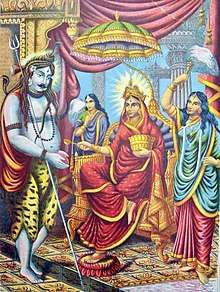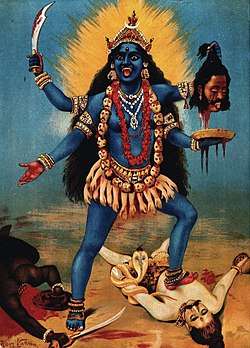Annapurna (goddess)
| Annapurna Devi | |
|---|---|
 Annapurna Devi (sitting on throne) giving alms to Shiva (left), a scene from Annada Mangal, colour lithograph, 1895. | |
| Bengali | অন্নপূর্ণা |
| Affiliation | Devi, Durga, Parvati [1] |
| Consort | Shiva |
Annapurna or Annapoorna (Sanskrit: अन्नपूर्णा, IAST: Annapūrṇa, lit. filled with or possessed of food)[1] is the goddess of food and nourishment in Hinduism. Worship and offering of food is highly praised in Hinduism and therefore, the goddess Annapurna is regarded as a popular deity. She is an avatar (form) of Parvati, the wife of Shiva.[2] and is eulogized in the Annada Mangal, a narrative poem in Bengali by Bharatchandra Ray. The Annapurna Sahasranam is dedicated to the goddess and praises her one thousand names while the Annapurna Shatanama Stotram is dedicated to her 108 names.
A few temples exist that are dedicated to her, the most prominent being the Annapurna Devi Mandir and the Kasi Viswanath Temple in Varanasi. Since Akshaya Tritiya is considered to be the birthdate of the goddess Annapurna, the day is believed to be very auspicious for buying gold jewellery.[3]
Etymology
Annapurna is derived from Sanskrit meaning the giver of food and nourishment. Anna (अन्न) means "food" or "grains" and pūrṇa (पूर्ण) means "full, complete and perfect".
It is believed that Mount Annapurna in the Himalayas is named after her as she is believed to be one of the daughters of Himavat, the king of the mountains.[4] The Western world name her the "Hindu God of Cooking" considering her association with food items.[5]
The other names of Annapurana are[6] -
- Viśālākshī (Sanskrit: विशालाक्षी) - she who has large eyes.
- Viśvaśakti (Sanskrit: विश्वशक्ति) - world power.
- Viśvamātā (Sanskrit: विश्वमाता) - mother of the world.
- Sṛṣtihetukāvaradānī (Sanskrit: सृष्टिहेतुकावरदानी) - she who is a boon granter for the sake of the world.
- Bhuvaneśvarī (Sanskrit: भुवनेश्वरी) - goddess of Earth.
- Renu - goddess of Atom.
- Annadā (Sanskrit: अन्नदा) - donor of food.
Legend
Parvati was told by her consort Shiva that the world is an illusion and that food is a part of this illusion called māyā. The Divine Mother who is worshiped as the manifestation of all material things, including food, became angry. To demonstrate the importance of her manifestation of all that is material, she disappeared from the world. Her disappearance brought time to a standstill and the earth became barren. There was no food to be found anywhere, and all the beings suffered from the pangs of hunger. Seeing all the suffering, Mother Parvati was filled with compassion and reappeared in Kashi and set up a kitchen. Hearing about her return, Shiva ran to her and presented his bowl in alms, saying, "Now I realize that the material world, like the spirit, cannot be dismissed as an illusion." Parvati smiled and fed Shiva with her own hands. Since then Parvati is worshiped as Annapurna, the goddess of Nourishment.[6]
Iconography
The Agamas (religious texts) describe the iconography of Annapoorna as a youthful goddess having red complexion with a face round like full moon, three eyes, high breasts and four hands. The lower left hand is depicted holding a vessel full of delicious porridge and the right with golden ladle adorned with various kinds of jewels. The other two hands depict the Abhaya and Vrata poses. She is depicted with wristlet and golden jewellery which rest on the chest. She is seated on a throne with a crest of moon adoring her head.[7] In some depictions, Shiva is shown standing to her right with a begging bowl, begging her for alms. Shankara in Annapoorna Stotra described the deity always holding a scripture, akshamala and opener of doors of Moksha in her hands in place of vessel and ladle, indicating his prayer to Annapoorna being spiritual perfection rather than food.[8]
Her Bhairava(consort) is Dashavaktra,who is ten-faced,thirty-eyed and ten-armed. He holds a trident, a sword, a thunderbolt, an axe, a goad, a tambourine, a bell, a noose and displays Varadamudra and Abhayamudra.
Literary sources
The goddess mentioned in Hindu religious texts such as the Rudrayamala, Sivarahasya, Annapurnamantratsava, Maha Tripurasiddhanta, Annapurna Kavacha, Annapurnahavamti, Annapurnamalininaksatramalika and Bhairvahyantantra.[6] Kumara Sambhavam by Kalidasa makes vivid mention about Varanasi and the deity Annapurna.
Devi Bhagavata written during the 3rd and 4th centuries CE refers Annapurna as goddess of Kanchipuram and Visalakshi as goddess of Varanasi. Skanda Purana written during the 7th century states the sage Vyasa was led to Varanasi by a curse and Annapurna came as a housewife and offered him food. Lingapurana mentions that Siva was begging for food for his children as he could not get food in the world due to a miracle created by his consort Parvati. Parvati came out as Annapurna and offered food to Siva at his doorsteps. The legend of Kasi Viswanath Temple in Varanasi is associated with the story that Siva built the temple there in her honour.[9] Adi Sankara (8th century), the proponent of Advaita school of Hinduism, has written Annapurna Stotra, a book glorifying the deity.
The mention of Annapurna is also found in Kumara Sambhava, a Telugu literature, by Nannechola, a Saiva poet of the 12th century. There is also a mention about the deity in Kasikhanda by Srinatha, a Telugu poet of the 13th century.[8]
Worship
Food is considered sacred as per Hindu Mythology and prayers are offered before consuming it. The person who identifies the importance of Annam (food) within the five layer of body helps carry life in the worldly process and subsequently seeks to identify Brahman, the enlightenment. Annadhanam, the donation of food, is highly praised in Hinduism. The importance of Annadhanam is prescribed in Vishnu Dharamottara, Agni Purana, Padma Purana, Kurma Purana, Nandi Purana and Vayu Purana.[6]
She is worshipped through the recitation of her thousand names and her one hundred and eight names. The Sri Annapurna Ashtakam composed by Shankaracharya is chanted by several devout Hindus around the world as a prayer for nourishment, wisdom, and renunciation. Before partaking of any food, Hindus chant the following prayer:
| “ | Oṃ Annapūrṇe sadāpūrṇe Śaṇkara prāṇa vallabhe jñāna vairāgya siddhyartham bhikṣām dehī ca pārvatī.
Māta me Pārvatī devī pitā devo Maheśvara bāndhavāḥ Śiva bhaktāsca svadeśo bhūvanatrayam. |
” |
| “ | Oh Annapurna, who is forever complete, more beloved to Lord Shiva than life. Oh Parvati give me the alms of Your grace to, awaken within me spiritual knowledge, inner freedom, prosperity, and spiritual attainment.
My mother is Goddess Parvati, my father is the Supreme Lord Maheshwara (Shiva). My relatives are the devotees of Lord Shiva, wherever they are in the three worlds. |
” |
The Annapurna Vrat Katha containing stories of her devotees are also recited by her devotees.
Temples
Though Annapurna is a popular deity, there are few temples dedicated to her.[8]
- The most well-known temple (Annapurna Devi Mandir) dedicated to Annapurna is in Varanasi, U.P.. Annapurna is the Goddess of the city of Kashi (Varanasi) where she is regarded as the queen of Varanasi alongside her consort Vishweshwar (Shiva), the King of Varanasi. In the temple, at noon time, food offerings to the Goddess are distributed to the elderly and disabled daily. During the Autumn Navaratri food is distributed on a larger scale.[10]
- In West Bengal her temples are found in Barrackpore . It was founded by Rani Rashmoni
- in Madhya Pradesh one temple is situated in indore Annapurna near lal bag fort
- The other famous temple is Annapoorneshwari Temple, situated at Horanadu in the Western Ghats CHIKKAMAGALURU of Karnataka, where afternoon and evening prayers are held after the devotees are fed.
- In Kerala there is temple in Chalappally village by the name Kunnam Annapoorneswari Devi Temple.
- Another famous temple of the goddess is situated in Cherukunnu, Kannur, Kerala by the name Annapurneshwari Temple, Cherukunnu.
- In Puducode town of Kerala, there is Puducode Annapoorneswari Temple, where the grand celebration of Navaratri held yearly with grand feast, which is crowded by thousands of devotees from all around the globe, those who have migrated and settled elsewhere.
- In Thodupuzha town, there is Thachukuzhikavu Annapoorneswari-Bhadrakali-Navagraha Temple.
- A temple for Annapoorna has been constructed near Watrap, on the way to Saduragiri. The temple is in the shape of eight-sided pyramid. Annapoorni temple named Andakasieswari is under construction at Achangudi near to Tiruvadanai Town in Ramanathapuram district in Tamil Nadu and another temple is under construction at Pathikonda, Kurnool district, Andhra Pradesh.
- In Hyderabad, her temples are found in Jafferguda. Her temples are there in Jalandhar and Bhatinda in Punjab.
- In Maharashtra her tempes are found in Bhandara and Akola.
- Her temples are also found in Gujarat. In Unjha, Gujarat, she is worshipped in as Umiya Mata. Some people in Gujarat and Rajasthan also consider Ashapura Mata as an incarnation of Annapoorna Mata. In Rajasthan, her temples are found in Mishroli village in Jhalawar district, Kagdara village in Pali district, There is one temple of Annapoorna Mata in Chittor Fort. It was built by Maharana Hamir Singh. There are other temples in the fort near the Annapoorna Mata temple which are dedicated to Baan Mata, Charbhuja and Lakshmi-Narayan. On the top of the Ramgarh hill, Rajasthan, Kisnai and Annapurna Devi temples are situated in the natural cave. Other temple is in irinjalakuda kunjilikattil annapoorneswari temple. This is a family temple of local exhaust community were the rituals are done by Brahmin priests[11]
See also
- Annapurna Devi Mandir
- Annada Mangal
- Devi (Hindu goddess)
- Durga
- Hindu temples in Varanasi
Notes
- 1 2 Williams, Monier. "Monier-Williams Sanskrit-English Dictionary". faculty.washington.edu.
annapūrṇa : pūrṇa mfn. filled with or possessed of food; (ā), f. N. of a goddess, a form of Durgā
- ↑ P. 2001, p. 13
- ↑ Nanu, Narendra (6 May 2011). "TOPSHOTS An Indian customer looks at a selection of white gold..." Getty Images. Retrieved 25 May 2015. – via HighBeam (subscription required)
- ↑ Osan, Gurinder (28 August 2002). "An Indian mystic, seeking his goddess, goes the hard way in the Himalayas". AP Worldstream. Retrieved 24 May 2015. – via HighBeam (subscription required)
- ↑ "Your Life: Currying Flavor; Zafron, Lisburn Road, Belfast food and drink". London, England: The Mirror. 5 January 2008. Retrieved 25 May 2015. – via HighBeam (subscription required)
- 1 2 3 4 P. 2001, p. 17
- ↑ P. 2001, p. 19
- 1 2 3 P. 2001, p. 20
- ↑ P. 2001, p. 18
- ↑ "Temples in Varanasi". Varanasi District administration. 2011. Retrieved 25 May 2015.
- ↑ "Places of interest in Baran". Government of Rajasthan. 2011. Retrieved 25 May 2015.
References
- P., Dr. Arundhati (2001). Annapurna - a bunch of flowers of Indian Culture. New Delhi: Concept Publishing Company. ISBN 81-7022-897-2.
- Saraswati, Swami Satyananda. Annapurna Puja and Sahasranam. ISBN 18-87472-85-1.
- Eck, Diana L. Banaras: City of Light. ISBN 81-87936-00-2.
- Kalidasa. Raghuvansa Mahakavya 1.1 ( the starting Shloka).
